When we think of precision agriculture, we typically think large scale. We conjure images of combines equipped with GPS guidance systems to harvest thousands of acres, or dairies with robotic milkers for several thousands of cows. But the concept of precision ag is simple: It encompasses any technologies, automations, and innovations used to improve agricultural operations no matter how big or small.
However, the assumption remains that leveraging technology is more financially feasible on large-scale farms. This assumption does bear some validity, but as technologies increasingly become more user-friendly and readily available, smaller-scale operations — where labor, money, and resources are limited — can leverage these tools as well.
Small-scale farmers (usually defined as having just a few acres) predominantly rely on family members for their labor and can subsequently make greater sacrifices when it comes to work life balance than a large-scale operation with dedicated employees.
“People often forget the price of their time, farmers often don’t charge their farm for their efforts or their family’s efforts,” said Melissa Cantor, assistant professor of precision dairy science at Penn State’s College of Agricultural Sciences “I think that the opportunity is there for tech and innovation to improve the quality of life on your farm.”
American Farm Bureau Federation economist Bernt Nelson concurs with Cantor, adding that “[technology] helps preserve your ability to work longer. We’re more efficient as people, we’re able to alternate and take turns. You have less fatigue; you have the ability to get more done on a farm. We’re able to better utilize our human resources.”
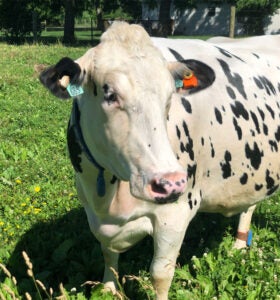
While Nelson may spend most of his days working in Washington, D.C., he is a North Dakota farm boy at heart. Recently, Nelson had to travel home for a period of time, trading his desk work for field work when multiple cancer diagnoses shocked his family. Nelson experienced firsthand how precision agriculture was able to assist the family during planting with limited hands on deck.
“We were moving slower because of my dad’s medical condition, and there were several nights where we went until midnight, two o’clock in the planter. But we don’t use markers anymore that you had to see [in the daylight] in order to go straight,” Nelson said. “Now? We can turn on some music, even a show if you would, and just hit a button. With those types of things, you get worn out less. We are human after all, even if we are some of the hardest workers on this Earth, we still wear out and get tired”.
The SMART approach to help manage stress includes factors such as engaging in healthy sleep, exercise and nutrition habits, but it also encourages rest. Taking a break from farm work to reset your brain and refresh your perspective sounds great in theory but difficult to put into practice with the daily demands of farming.
The heavy lifting of precision ag
While automation allowed for the Nelson family to navigate a medical emergency during one of their busiest times of the year, farmers are increasingly realizing that technologies can save time and labor year-round, allowing for those all-important opportunities to de-stress and rest.
“When you have a single platform, a single method that has steps to operate that piece of equipment … somebody can relieve you, it allows you to have that mental headspace where you’re not as worn out as you would have been without it,” Nelson said. “All of those things add up when you talk about your mental health as a farmer and as a farm family.”
Cantor gives an example of the feedback she’s heard regarding automations on small scale dairy farms, explaining that “the number one thing I hear from someone who puts an automated milking system on their farm and is successful at it is that they cannot put a price on going to the baseball game for their grandson, they can’t put a price on going to a wedding.”
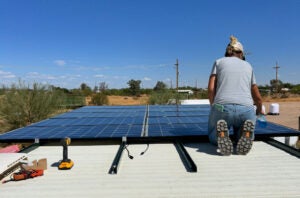
At 6th Day Farms in Arizona, the Connelly family has a lot on their plate. Michael Connelly, his wife, Jennifer, and two young daughters run a flock of 2,000 meat chickens, singlehandedly raising, processing, and distributing products from their four acres in Maricopa to the local community.
In addition to running the farm, Michael pastors their local church, works as head engineer at their point-of-use solar start up, Agora Innovations, and is president of Maricopa Pantry, the community food bank his family runs. The Connellys credit technology for helping them to juggle their tasks much more efficiently. One example is the antenna Connelly fixed to the roof of their home that collects data and feeds it to a tablet. This allows them to have a centralized info base to monitor everything from temperatures and moisture levels in their fields, carbon dioxide concentration in their chick brooders, and the solar power levels in their processing plant on site and food bank refrigerators and freezers a mile down the road from their home.
Elsewhere, for David Lukens, owner of Grace Harbor Farms, a small family owned and operated creamery in Washington state, the benefits of automating their bottle filling system has had a major impact on being able to meet their busy season demands without overextending their workforce of 24 employees, several of which are part time.
“The holidays are always super busy, and this opens up the door so we’re not going to be working super long hours during the holidays and pushing people beyond what is comfortable,” Lukens said.
Lukens credits this automation for not only their reduction of labor and overtime hours, but better throughput, money savings on labor, and improved crew morale.
Implementing new tech
The opportunity for small-scale farmers to utilize technologies to streamline their production and decrease cost, labor and inefficiencies may seem like a no-brainer, but one of the biggest roadblocks to achieving these improvements is typically the hesitation regarding the initial cost of implementing these technologies.
Lukens understands this hesitation to invest in expensive technology on a small operation when your budget is tight.
“What 16-year-old should go out and buy a brand new car?,” he said with a laugh. But Lukens insists, “There’s always ways of mitigating risks [financially].”
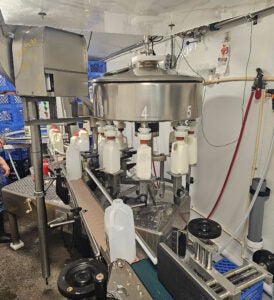
Lukens recommends that small-scale farmers seek high-quality used equipment. At Grace Harbor Farms, Lukens has seen firsthand how acquiring used equipment has benefitted his production process and cut down on financial output.
“There’s always a bottleneck in business, no matter what. There’s always something that kills time, [requires] labor, and in our case, no pun intended, our bottler was the bottleneck,” he said.
The used bottle filler that Lukens found was able to be rebuilt to fulfill all the current food safety regulations and has been a major boon to the business.
“Get creative. Lease something or build something on a very small scale — there’s a lot of used equipment out there, I’m a big proponent of that,” Lukens said. “New is great and all, but unless you’ve got millions and millions of dollars flowing through your company, go buy used, inspect it, clean it, and do it.”
Cantor echoes his advice, explaining that many farmers are seeking alternatives to buying tech brand new.
“Rental programs are becoming more popular so if you’re not 100 percent sold, you can rent the tech for x amount of time,” Cantor said.
Lav Khot, associate professor of precision ag at Washington State University’s College of Agricultural, Human, and Natural Resource Sciences believes that leasing equipment will also allow farmers to stay on the cutting edge with equipment as technology evolves, saying purchasing outright is impractical, especially at the rate of innovation that is occurring.
“You can’t buy [equipment] that is $20,000 dollars and then after two years things change, and you need to sell that and get something new,” Khot said.
Whether testing the waters with used or rental equipment, there is an opportunity to find what works for your operation without breaking the bank.
“Every situation is different, every budget and break-even is different but the ability is there to retrofit those [technologies] to whatever your needs might be,” Nelson said. “There’s a place for everyone to come to the table, I truly believe that. And I don’t think you’ll find that becoming more efficient will ever be a bad thing.”
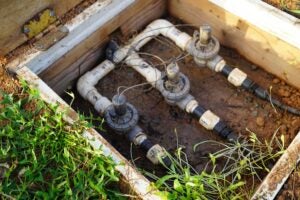
And if used equipment and rental programs aren’t available, the good news is researchers and creators who are testing and developing new technologies are keeping a farmer-centric approach.
“In the research I have done, there has always been some sort of social scientist interacting with the farmers, understanding their needs, the barriers and how we can overcome these barriers,” said Simone Silvestri, associate professor in the University of Kentucky’s Department of Computer Science.
According to Silvestri, researchers are aiming to develop innovations that provide solutions without the sticker shock.
“We have a cost aware approach, trying to understand how your initial budget, your initial investment can help,” Silvestri said. “We are going towards a direction in which we can make technology that is not as expensive, still be useful.”
Efforts toward expansion
While often, the return on investment requires a wait time, sometimes technologies can make immediate impacts to operations and expenditures.
The Connelly family is making the most of the abundant Arizona sun and their use of solar technology is an example of how costs can be significantly reduced in the short term thanks to innovation. The Connellys used to run their entire meat processing plant off of a generator.
“That cost between $50 and $75 dollars a week, $2,400 a year,” said Connelly.
Four years ago, they decided to try solar. The initial, one-time cost to set up the entire plant (all lighting, two freezers, chicken plucker, vacuum sealer, air conditioning, and swamp cooler) on solar power? $2,800.
Additionally, utilizing a solar powered mobile freezer system Connelly built in the bed of his truck, they have eliminated one cost from their product distribution at markets.
“It probably took five gallons of gas to run a freezer at market, maybe more,” said Connelly. “Now it doesn’t cost me anything”.
For precision ag in general, Silvestri doesn’t believe the financial hesitation will be as much of a barrier in the near future.
“I think we are going to see a significant expansion of these technologies,” Silvestri said. “The research we are doing is going to advance and make it less expensive and more acceptable. … These technologies are going to become cheaper and cheaper. The more we have a demand for it, the more it’s going to be easier to develop them and the cheaper it’s going to be for the [consumer].”
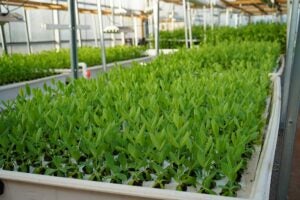
Additionally, in March 2023, several bills were introduced to help aid in the adoption of precision ag tech. The Precision Agriculture Loan Program (PAL) Act is a bipartisan bill designed to establish a Farm Service Agency loan program to support farmers purchasing precision agriculture equipment. This loan program would be the first federal loan program focusing on creating loans (at interest rates of 2 percent or less with terms ranging from three to 12 years) specifically for precision agriculture tech that improves efficiency or reduces inputs.
The Producing Responsible Energy and Conservation Incentives and Solutions for the Environment (PRECISE) Act is another bipartisan precision ag bill that aims to increase farmers’ access to precision agriculture equipment by leveraging existing USDA programs like the Conservation Stewardship Program and Environmental Quality Incentives Program.
In addition to legislation to make precision technology more financially feasible for farmers, in 2018, the Precision Agriculture Connectivity Act was passed as a part of the 2018 farm bill to address internet connectivity issues that impact precision ag. This act created a task force at the Federal Communications Commission assigned to dive into the connectivity and technology needs of precision agriculture.
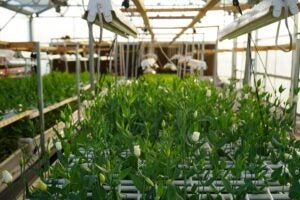
Accessing high speed internet to run precision ag tech is key, and flower farmer Tom Precht, co-founder and vice president of Grateful Gardeners, believes the ag industry “needs [connectivity] just as much as anybody else needs it, if not more,” he said. “What we’re talking about here is data collecting. We need to be assessing the fields, we need to be monitoring the fields. You can have all these sensors, but unless you have a way to broadcast it back to a centralized location to store it in the cloud, it slows the whole process down.”
The know-how behind the tech
While cost and connectivity concerns account for some primary hesitations to adopt tech, another prominent fear is how much the technical know-how is needed to utilize these tools. For example, Connelly’s background as an electric mechanical engineer has served him well, but, according to Cantor, you shouldn’t let unfamiliarity with technology prevent you from pursuing it.
“You don’t have to be some machine learning, ChatGPT guy to do this and make it work as long as you have a person that is dedicated to it,” Cantor said. “And as long as you have a routine maintenance plan in place, I think anyone can use the tech.”
Nelson adds that patience with the process is key.
“There is a learning curve, and that’s one of the hard things with adapting to this,” he said. “When you have to think and learn and troubleshoot this stuff, you may experience some downtime.”
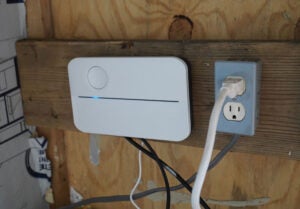
Cantor recommends tapping into the resources you already have around you to learn how to operate these technologies.
“People are really afraid of using software or perhaps making it work on their farm, but veterinarians work with these a lot now. And even herd nutritionists, they all work with software. That’s somebody to tap a resource into that’s already on your farm,” she said.
For the folks who have taken the plunge to leverage precision ag technology, the initial cost and stress of adoption is outweighed by the benefits experienced by the farmers, their crops, and livestock, as well as the environment.
“Farmers get a bad rap with carbon emissions and everything else, and the more we can reduce our carbon footprint the better,” Connelly said. “Solar is so easy for us, and so we’re able to reduce our carbon footprint very easily. There’s a million other ways.”
One of the ways that Nelson has seen precision ag aid the agriculture industry in becoming more environmentally friendly is targeted application of chemicals on crops using drones. These drones are equipped with identification systems that can locate and target an invasive plant or pest in a crop.
“It’s better for the environment — we talk about chemical runoff or excess fertilizer use, [precision ag] helps prevents all of these things,” Nelson said. “Not only are we purchasing less, but we’re using less, and thus we’re having a smaller footprint on our environment around us.”
In addition to using solar energy, the Connellys are using tech to improve their resource management.
“Water is a big thing out here [in Arizona], we’re very water conscious,” Connelly said. “We use sensors here at the farm that measure soil moisture, soil temp, so we only irrigate when the sensor tells us we need to.”
Across the country in Maryland, Precht is blazing the trail in the precision irrigation space, showing small farmers how automating their irrigation can be a tremendous time, labor, and resource saver. Prior to his foray into flower farming, Precht obtained his Ph.D. in pharmacology and biochemistry, with nearly a decade of research experience across areas such as cell culture, molecular biology, and other biochemical assays. Now, Precht is using his love of research to dive into how innovation can carry agriculture into the future.
Precht’s two acres of land under cultivation may not seem like a lot, but he and his wife, Sarah, for a long time have been the only ones running the show, up until the recent hire of their first full-time employee. Feeling the effects of being shorthanded, Precht saw an opportunity to automate their irrigation system to save time and labor.
Using electronic irrigation controllers, Precht set up a manifold out in the field, ran drip tape, and broke the system into zones. Each zone, controlled by an electronic valve, is hooked up to the main water source and connected to Wi-Fi, thus connected to the weather predictions and reports.
But Precht doesn’t settle for the generic regional weather stations when it comes to his garden. Precht encourages people to get an internet enabled weather station to collect data specific to their precise location.
“The problem when using your weather app is they are taking an average of all of these different sites in the area,” Precht said. “And it’s pretty reliable, but microclimates are starting to become much more relevant, especially on a smaller-scale farm.”
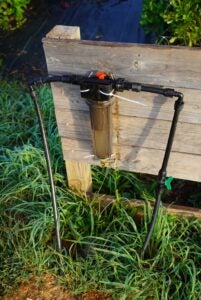
With the combination of the internet-enabled irrigation controllers and personal weather station, Precht can watch the notifications via his phone as the automated system makes decisions on the fly.
“It literally can say, hey, you got x amount of water in the last 24 hours, your soil is plenty saturated, you don’t need to irrigate, and it’ll shut it off automatically,” he said. “It can also say, we’re predicting x amount of precipitation so we’re going to shut it off. If it doesn’t rain, it’ll make sure it turns on.”
This real-time decision making done by Precht’s system takes a huge load of his mind and allows him to save his mental and physical energy other tasks.
“Ultimately what it really has done is freed us up. We just don’t have to think about it,” he said. “This isn’t just a nerdy tech thing; you’re saving time and money and you’re getting something back that you really can cherish.”
How to get started
For farmers interested in integrating technologies and automations into their operation, Cantor has some recommendations. As someone with boots on the ground experience helping farmers adopt technology on their operations, she believes the following steps can be a helpful, high-level guide into adopting precision ag tech.
- Identify the main bottleneck tech can resolve for you. Cantor recommends picking one main priority to solve for. “Hesitations come sometimes because people try to change everything at once and that is overwhelming,” she said.
- Conduct preliminary research on the tech you’re interested in. Using a platform such as Google Scholar, Cantor said to ensure there is documented research out there that has actually evaluated the technology and company you’re interested in. “Make sure it’s been scientifically validated,” she said. “Sometimes companies will make big claims and there actually won’t be a particular article to support that. Be your own advocate.”
- Utilize your free resources for recommendations (e.g., your extension office, your vet, fellow farmers who are utilizing the technology you are interested in, etc.). Silvestri recommends evaluating operations that are similar to yours to see what technology they are leveraging and the benefits they are seeing. “Look at systems that are well established and have proven records of success,” Silvestri said. Washington State University’s Gary Fredricks, small farms, urban horticultural and master gardener coordinator believes that finding a mentor within the farming community is key. “I don’t know too many farmers who say, ‘I don’t want to talk to you.’ They love to talk,” said Fredricks. “And they’ll give you honesty, and I think going back to the farming community … those are the innovators, they’ve already made it work, they are the ones to talk to.”
- Make sure your facilities are already in place to make the tech successful. Do not put the cart before the horse: (e.g., if you’re looking at something to help with early detection of illness in livestock, what is your protocol to treat that illness once it’s detected?). Also, don’t overestimate what your technology is capable of. Nothing is perfect, and it is key to manage your expectations and “calculate the inefficiencies in the system,” Connelly said.
The future of farming is one that will be aided by the adoption of technology, and the small-scale farmer can be a beneficiary.
But as farmers, we’re often not the most open to change. Tried and true methods that have been handed down through the generations seem as good as any. But the world is evolving, and with it, many operations need to as well.
The business of farming must scale with the times.
“Continuous improvement is key in business, if you’re not trying to continuously improve your business and the production systems, as well as your personal life, it’s not good,” said Lukens.
As with any automation of processes previously handled by humans, questions are swirling surrounding precision ag. Does this mean milking robots will replace farm workers? Will self-driving tractors put people out of work?
Nelson recognizes the concern about replacing jobs held by people, but added, “We’re already in an industry that’s facing labor issues, so anything we can do to make that more efficient to require less strain on less bodies is a good thing.”
Connelly agreed, saying, “We need to automate more processes so the ones of us that are out here can still farm, because this is getting really hard.”
On top of the myriad of challenges small farmers face is the task of competing with large scale commercials farms. Though small farmers will never be able to feed the masses, technology can help even the playing field from the operational standpoint. “It can help with … honestly making small farmers survive,” said Silvestri.
Precht believes that technology will appeal to a younger generation of people who are often reluctant to enter the ag industry due to how demanding the lifestyle is.
“I understand why people would be turned off from [farming] if it’s just eight to 10 hours of manual labor per day,” he said. “The thing that I’m encouraged most about with tech is the hope that it would bring in more people to agriculture. We need to make it more appealing to more people.”
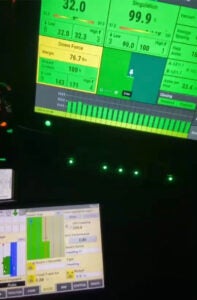
Additionally, Cantor said that utilizing technology can help promote agriculture as an industry.
“While some of us in the farming industry might be a little bit more apprehensive about tech and scared to adopt it, our consumers love technology and are highly supportive of that,” she said. “I think they will appreciate that you have an Apple Watch, basically, on each cow telling you how she’s doing.”
At the end of the day, the business of farming has one mission: to create quality products for a growing population of consumers. Lukens is passionate about thinking outside the box and embracing innovation to make it happen.
“I’m for the industry,” he said. “There are people born every day that have to eat. I’m not going to feed every person in the world, so let’s help the industry survive, let’s help people bring good products to market.”
Maggie Bright is a small farmer who was born and raised in Washington state. Maggie grew up showing dairy cattle in 4-H and currently works part-time as a relief milker on a local registered Holstein dairy. Maggie is passionate about highlighting the people whose innovation and ingenuity fuel the future of agriculture.



